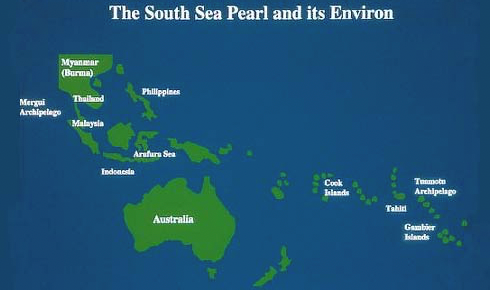About Pearls

Pearls have been considered the most magical and feminine of all gems and are the only one created by a living organism. Due to their natural beginnings, pearls emanate a certain warmth and glow not found in other gems.
Australian South Sea Pearls are found in pearl oysters. However, the origin of the pearl mystified humans for centuries. Many theories were put forward regarding the origin of pearls however, it wasn’t until the turn of the twentieth century that the relationship between pearl oysters and parasites was discovered.
Pearls were created when a foreign body of some sort, such as a grain of sand or a parasite, found its way into a pearl oyster. The oyster reacted by coating the irritant with layer upon layer of the pearly substance known as ‘nacre’, that gives the pearl its unique appearance and iridescent beauty. This unique relationship gave birth to the natural pearl.
The cultured pearl was created as a way of guaranteeing a steady supply of pearls and satisfying the demands of the consumer. Cultured pearls are formed with a helping hand. In this case, humans rather than nature introduce the irritant: a bead or nucleus is inserted into the oyster by a technician to create a pearl which turns out every bit as natural as one that originated in the wild.
Due to the rarity and high price of natural pearls, cultured pearls feature predominantly in jewellery stores. Side by side, it is very difficult to tell the difference between a natural pearl and a high-quality cultured pearl with the naked eye.
Pearls are composed of between 82-86% mineral (calcium carbonate), 10-14% organic binder and 2-4% water. They are very soft and can be chipped quite easily.
The name ‘pearl’ has various origins. The Teutonic derivation comes from the noun beere, meaning berry. Latin derivations are pirium, a sphere, and pirula, a pear. The Romans used the Greek word margarita, describing something of unique value, a cherished possession or a favourite child.
The pearl is the birthstone for June, and also the anniversary gem for the Third and Thirtieth Wedding Anniversaries. Recognised as the emblem of modesty, chastity and purity, pearls have also come to symbolise a happy marriage.
Cultured Pearls
Pearls are cultivated in areas which have the right water temperature, are clean and nutritious. The following are the locations where cultured pearls-both saltwater and freshwater-are recovered.
Saltwater Pearls
Australia
Although originally a source of mother-of-pearl for many thousands of years, Australia is now a main producer of cultured South Sea Pearls.
South Sea
The South Sea area is responsible for producing the world’s largest and finest saltwater cultured pearls. The area extends from Burma and the Gulf of Thailand through the Sulu Sea of the Philippines, Malaysia, the Indonesian Arafura Sea and north-west Australia. It continues into the Cook Islands, eastward through Tahiti to the Tuamotu Archipelago and the Gambier Islands in French Polynesia. The Philippines, Malaysia, Indonesia, Australia, Cook Islands and Tahiti produce the much sought-after South Sea cultured pearls.

Freshwater Pearls
China
Japan
United States of America
VALUING PEARLS
Lustre
The most important indication of a pearl’s quality is lustre. The lustre of a pearl refers to the glowing appearance of its surface and is judged by its brilliance and ability to reflect light. A pearl with a high lustre will be very shiny and show reflections like a mirror while a pearl with poor lustre will appear very milky or chalky.
Lustre is determined by the quality of a pearl’s nacre- its transparency, smoothness and overall thickness. Factors affecting the quality of the nacre include the cultivation place, the health of the mother oyster, the length of time spent in the oyster, pollution and the type of oyster used. Only strong layers of nacre can produce deep lustre.
It is better not to compromise on lustre as this feature cannot be hidden or enhanced by its jewellery mount.

Colour
Pearls present a whole palette of colours to choose from. Light coloured pearls are produced in shades of white, pink, silver, gold and blue, while dark coloured pearls range from peacock green and aubergine purple to all the shades of grey.
Above all, a pearl’s colour is a question of personal taste. Although some shades are especially rare or popular and therefore highly valued, such as rosy white, silvery white and pale gold, the colour of a pearl is certainly not an indication of its quality.

Shape
Pearls present a whole palette of colours to choose from. Light coloured pearls are produced in shades of white, pink, silver, gold and blue, while dark coloured pearls range from peacock green and aubergine purple to all the shades of grey.
Above all, a pearl’s colour is a question of personal taste. Although some shades are especially rare or popular and therefore highly valued, such as rosy white, silvery white and pale gold, the colour of a pearl is certainly not an indication of its quality.
- Round Off-round
- Semi- baroque
- Baroque
- Slightly round or “ovalish”
- Not round. Some examples are pear, drop, egg and button shapes.
- Very irregular in shape with a surface that is often very uneven, occasionally resembling teeth, cacti, tadpoles and mushrooms
Throughout history, the round pearl has been considered the most valuable and popular shape. However, most of the world’s most famous and valuable pearls are often not symmetrical in shape, and that is because the other grading factors are also important.
Shape is a good category to compromise on if you need to cut down on price. Actually, baroque and circled pearls can make for very interesting jewellery pieces.

Surface
The fewer the spots or blemishes a pearl has, the higher its value. But again, flaws can also be positive features. They may serve as identifying marks that a pearl is yours and not somebody else’s and help prove that it is real and not imitation. Flaws can also lower the price of a pearl without necessarily affecting its overall beauty.

Size
The size of a pearl is expressed in terms of its diameter, which is measured in millimetres. Size has a significant impact on price. One millimetre’s difference has been known to raise a price by between 100 and 200 per cent.

CARING FOR PEARLS
Remember that a pearl is not a rock!
Pearls can keep their beautiful lustre for centuries, when the generations of owners remember how these jewels of the sea differ from other precious gem material.
Proper care of pearls is not difficult, and it is merely a matter of remembering that these gems are organic by nature, grown in water from living cells of a living creature. Like the oysters which formed them, they require moisture… but because they usually are worn on a silk string which will deteriorate when wet, the pearls will need to be re-strung more frequently if they are taken for a swim in salt or fresh water. Never expose to chlorinated water. Like their “organic” owners, pearls are prone to damage from pollution and injury. They can’t stand the heat, and they should definitely stay out of the kitchen.
What to do

STORE PEARLS SEPARATELY
from other jewellery, in a cloth bag or jewellery pouch. Storage in slightly damp linen will help prevent pearls from drying out in low-humidity atmospheres including central heating.

APPLY COSMETICS, PERFUME AND SPRAY PRODUCTS FIRST
before putting pearl jewellery on. (Remember although sun creams and insect repellents are good for you, pearls need to be protected from these protectors.)

REMOVE SPILLS IMMEDIATELY
if pearls come in contact with food acids. Use a soft cloth moistened in fresh water, and then dry pearls with another soft cloth.

WIPE PEARLS AFTER WEAR
using a soft cloth. Avoid commercial jewellery cleaners unless specified on the label.

RE-STRING pearls regularly
for the sake of the pearls as well as to avoid a broken string. Makeup, powder and grime will form a soft, gluey paste on the string, attacking both the silk and the pearls.

REPLACE INDIVIDUAL PEARLS
when a competent pearl-stringer recommends it. Pearls which always lie against the neck when worn will absorb acid from the skin and eventually lose lustre as well as their spherical shape.
What to Avoid
- Perspiration.
- Acids in the skin and elsewhere.
- Makeup and skin creams.
- Perfume.
- Hairspray and insect repellent.
- Talcum powder.
- Dust and grit.
- Ultrasonic cleaners.
- Steam cleaning.
- Soap.
- Detergent.
- Chlorinated water in the shower or pool.
- Scratches from crystalline gemstones and metallic jewellery. Dehydration from being wrapped in cotton wool or from exposure to light and heat especially spotlights in shop windows and showcases.
- The dinner table with a variety of acidic hazards from vinegar to salad dressing to fruit juice.
- The kitchen with all those acidic ingredients and the high heat used in cooking. Pearls will tolerate temperatures up to 100°C for a short time, but hot fat and stove/oven temperatures often reach a very damaging 180°C! For the same reason, pearls should not be stored near a radiator or a sunny window.

